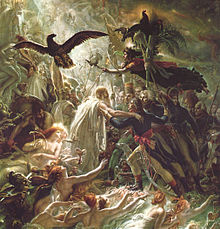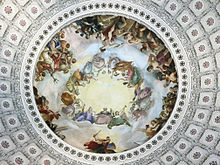Apotheosis: Difference between revisions
Wickethewok (talk | contribs) m rmv trivialink to del'd article |
|||
| Line 16: | Line 16: | ||
Apotheosis could also be applied to members of the imperial family such as emperors' wives like [[Livia]] or (in an apotheosis portrayed on the [[column of Antoninus Pius]]) [[Faustina the Elder|Faustina]] and, as an acceptable means of emperor-worship to the senate (worship of living emperors being regarded with suspicion), was a critical part of the [[imperial cult (Ancient Rome)|imperial cult]]. |
Apotheosis could also be applied to members of the imperial family such as emperors' wives like [[Livia]] or (in an apotheosis portrayed on the [[column of Antoninus Pius]]) [[Faustina the Elder|Faustina]] and, as an acceptable means of emperor-worship to the senate (worship of living emperors being regarded with suspicion), was a critical part of the [[imperial cult (Ancient Rome)|imperial cult]]. |
||
In an even rarer occasion, non-imperial Romans could be deified as well. The last non-imperial human to be deified was [[Antinous]], the young lover of [[Emperor Hadrian]]. The apotheosis of Antinous became the subject of numerous sculptures commissioned by Hadrian to commemorate the youth. Consequently, the deified image of Antinous is among the most recognizable faces from antiquity. |
|||
===In literature=== |
===In literature=== |
||
Revision as of 00:15, 21 June 2007
Apotheosis means glorification, usually to a divine level, coming from the Greek word ἀποθεόω, "to deify".
Pre-Roman
In the Greek and Hellenistic world, state leaders might be raised to the gods before (eg, Alexander the Great) or after (eg, the Ptolemaic dynasty) death. It was also an honour given to a few revered artists, such as Homer [1].
Roman
Apotheosis is most commonly used to refer to the Roman pagan process whereby an Emperor, empress, hero or leader was recognized to be divine by decree of the Senate or popular consent. Some Roman emperors underwent apotheosis upon their deaths. The process involved the creation of a waxen image of the emperor sitting in state, adorned with rich raiments and jewelry for a period of days, after which it would be burnt. On the pyre would be a hidden cage with an eagle in it. At the climax of the ceremony, this eagle would be released, and would be said to be carrying the emperor's soul to the gods.
It had its origins in the worship of Romulus, who became known in his deified form as Quirinus, and in the declaration by the Senate of Julius Caesar as a god after his assassination in 44 BC, an act that consolidated Augustus's power (Caesar was his adoptive father, and so he became "divi filius", son of the deified Caesar) but shocked the urbane opinion of the Roman elite. When Augustus died 58 years later, he received similar honors, thus setting the pattern for future emperors.
The apotheosis of an Emperor was an essentially political act performed by the dead emperor's successor to reinforce the majesty of the imperial office, and, more immediately, to associate the current emperor with a well-regarded predecessor, as in Augustus' case. For instance, when Septimius Severus overthrew Didius Julianus to gain power in AD 193, he arranged the apotheosis of Pertinax, who had ruled before Julianus. This allowed Severus to present himself as the heir and successor to Pertinax, though the two were not related.
Emperors who had been deified were referred to with the word 'divus' (Latin, noun, for "divine or deified - feminine diva, plural divi/divae) before their names. Thus, Claudius was called 'divus Claudius.' This word is often rendered as 'god' (i.e., "Claudius the god") but that is something of an overtranslation; a better translation might be 'divine' (i.e., "the divine Claudius") or deified, a somewhat softer formulation that Roman intellectuals could comfortably understand as metaphorical. As time passed, this honour became more and more automatically associated with dead emperors, to the extent that by the time of the Dominate it might just as well be understood as meaning 'late' (i.e., "the late Claudius"). The fact that 'divus' had lost much of whatever truly religious meaning it had is made clear by the fact that it was used with names of early Christian emperors after their deaths (e.g., "divus Constantinus"). Nevertheless, the oncoming of Christianity abolished the practise.
Apotheosis could also be applied to members of the imperial family such as emperors' wives like Livia or (in an apotheosis portrayed on the column of Antoninus Pius) Faustina and, as an acceptable means of emperor-worship to the senate (worship of living emperors being regarded with suspicion), was a critical part of the imperial cult.
In an even rarer occasion, non-imperial Romans could be deified as well. The last non-imperial human to be deified was Antinous, the young lover of Emperor Hadrian. The apotheosis of Antinous became the subject of numerous sculptures commissioned by Hadrian to commemorate the youth. Consequently, the deified image of Antinous is among the most recognizable faces from antiquity.
In literature
As apotheosis became a part of Roman political life in the late Republic and early Empire, it began to be treated in literary contexts: In the Aeneid, Virgil depicts Aeneas' deification, saying he will be taken up to the stars of Heaven, and mentions Caesar's apotheosis. Ovid also describes Caesar's apotheosis in book XV of Metamorphoses and looks forward to the glorification of Octavius.
The notion of apotheosis was parodied by Lucius Annaeus Seneca in his Apocolocyntosis divi Claudii (The Pumpkinification of the Emperor Claudius), in which Claudius is transformed, not into a god, but into a pumpkin. This satirical work not only pokes fun at the notion that the notoriously clumsy and ill-spoken Claudius might be a deity, but also reveals a certain irreverance towards the idea of ruler cult, at least among Rome's educated classes.
Modern


Later artists have used the concept for motives ranging from real respect for the deceased (Constantino Brumidi's fresco "The Apotheosis of George Washington" on the dome of the United States Capitol Building in Washington, D.C.), to artistic comment (Salvador Dalí's or Ingres's Apotheosis of Homer), to comedic effect.
Many modern leaders have also exploited the artistic imagery, if not the actual worship, of apotheosis. Examples include Rubens's depictions of James I of England at the Banqueting House (an expression of the Divine Right of Kings) or Henry IV of France, or Appiani's apotheosis of Napoleon.
Popular Culture
- In an episode of the animated series The Tick, the character Sewer Urchin refers to himself as "the apotheosis of cool."
- There is also an episode of Babylon 5 called "Falling Toward Apotheosis"
- At the beginning of Stephen King's The Gunslinger, the first in his Dark Tower series, it memorably describes the series' thematic desert setting as "the apotheosis of all deserts".
- Joseph Campbell, in his book The Hero With a Thousand Faces, writes that the Universal Hero from monomyth must pass through a stage of Apotheosis. According to Campbell, apotheosis is the expansion of consciousness that the hero experiences after defeating his foe.
- Alan Bennett: In his play The History Boys, the character of Irwin in speaking about the disolution of British monastaries refers to their Apotheosis and is criticised by his director for the use of the word. Irwin remarks "It is BBC 2".
- The strongest attack of the character Sagi from the video game Baten Kaitos Origins is called "The Apotheosis".
- A weapon in The Elder Scrolls IV: Oblivion is called Apotheosis. It is a magical staff which causes 33 points of all elemental damage at once. It is considered to be one of the most powerful and most useful staffs in the game.
See also
- Amaterasu
- Cult of personality
- Divinization
- Euhemerus
- Frazer, James, The Golden Bough
- Graves, Robert, The White Goddess
- Imperial cult
- Hirohito
- Roman emperor
- Roman religion
- Sacred king
- Theosis
- Tylor, E.B.
External links
- Seneca's Apocolocyntosis at Project Gutenberg

